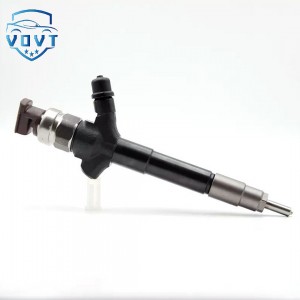High Quality Auto Parts Diesel Fuel Injector 093500-6930 Fuel Injector Engine Parts
Products Description
| Reference. Codes | 093500-6930 |
| Application | / |
| MOQ | 4PCS |
| Certification | ISO9001 |
| Place of Origin | China |
| Packaging | Neutral packing |
| Quality Control | 100% tested before shipment |
| Lead time | 7~15 working days |
| Payment | T/T, L/C, Western Union, Money Gram, Paypal, Ali pay, Wechat |
How to ensure the reliability of the emission control system working in conjunction with the fuel injection system?
System design and development
Precise control strategy formulation: During the system design phase, precise control strategies are formulated through a large number of experiments and simulations. For example, according to different engine operating conditions, environmental conditions and fuel characteristics, the matching relationship between fuel injection quantity, injection timing and emission control parameters is accurately planned so that the two systems can work together in various situations.
Redundant design and safety mechanism: Redundant design is adopted to set up backups for key control links and sensors. When the main system fails, the backup system can take over the work in time to ensure the continuity of collaborative work. At the same time, a safety mechanism is set up. When the system detects an abnormal situation, it can automatically take protective measures, such as limiting engine power, to prevent excessive emissions or component damage due to system failure.
Strict system testing and verification: During the vehicle development process, a large number of bench tests and road tests are carried out. By testing the collaborative work of the emission control system and the fuel injection system under different operating conditions and environmental conditions, data is collected and analyzed to timely discover and solve potential problems. For example, tests are carried out in extreme environments such as high temperature, low temperature, and high altitude to ensure the reliability and stability of the system.
Component quality and selection
Selection of high-quality components: Select components with reliable quality and stable performance, such as oxygen sensors, fuel injectors, EGR valves, etc. The quality of these components directly affects the collaborative working effect of the two systems. Choose brand products with good reputation and quality certification to ensure that they can work accurately in long-term use.
Optimization of component matching: According to the characteristics of the engine and vehicle, accurately select and match the components of the emission control system and the fuel injection system. For example, the flow characteristics, response speed and other parameters of the fuel injector should match the engine's intake volume, combustion requirements and emission control requirements to ensure the accuracy of fuel injection and emission control.
Vehicle use and maintenance
Regular maintenance and inspection: Car owners should regularly maintain and inspect their vehicles in accordance with the requirements of the vehicle manual. This includes checking whether the components of the emission control system and fuel injection system are damaged, aged, blocked, etc., and replacing worn parts in a timely manner. For example, regularly replacing air filters and fuel filters to ensure the cleanliness of intake air and fuel is conducive to the normal operation of the system.
Correct use and operation: When using the vehicle, users should follow the correct operation method, avoid bad driving habits such as sudden acceleration and sudden braking, and reduce the impact and damage to the emission control system and fuel injection system. At the same time, pay attention to the use of fuel and lubricants that meet the requirements of the vehicle. Poor quality fuel and lubricants may affect the performance and reliability of the system.
Timely handling of faults: Once the vehicle's fault warning light is on or the vehicle is found to have abnormal emissions, power reduction and other problems, it should be promptly inspected and repaired at a professional repair shop. Maintenance personnel must have professional knowledge and skills to accurately diagnose and solve faults that occur in the coordinated work of the emission control system and the fuel injection system.
Application of monitoring and diagnostic technology
Upgrade of the on-board diagnostic system (OBD): Continuously upgrade and improve the on-board diagnostic system so that it can more accurately monitor the working status of the emission control system and the fuel injection system. The OBD system can detect faults in the system in real time and prompt users and maintenance personnel in the form of fault codes, so as to facilitate timely discovery and resolution of problems.
Remote monitoring and data analysis: Use vehicle networking technology to remotely monitor the vehicle's emission control system and fuel injection system. By collecting and analyzing vehicle operation data, automakers and relevant departments can timely understand the working status of the system, identify potential problems, and provide users with preventive maintenance suggestions to improve system reliability.




















